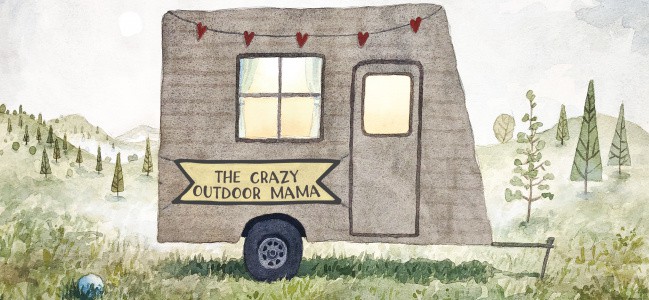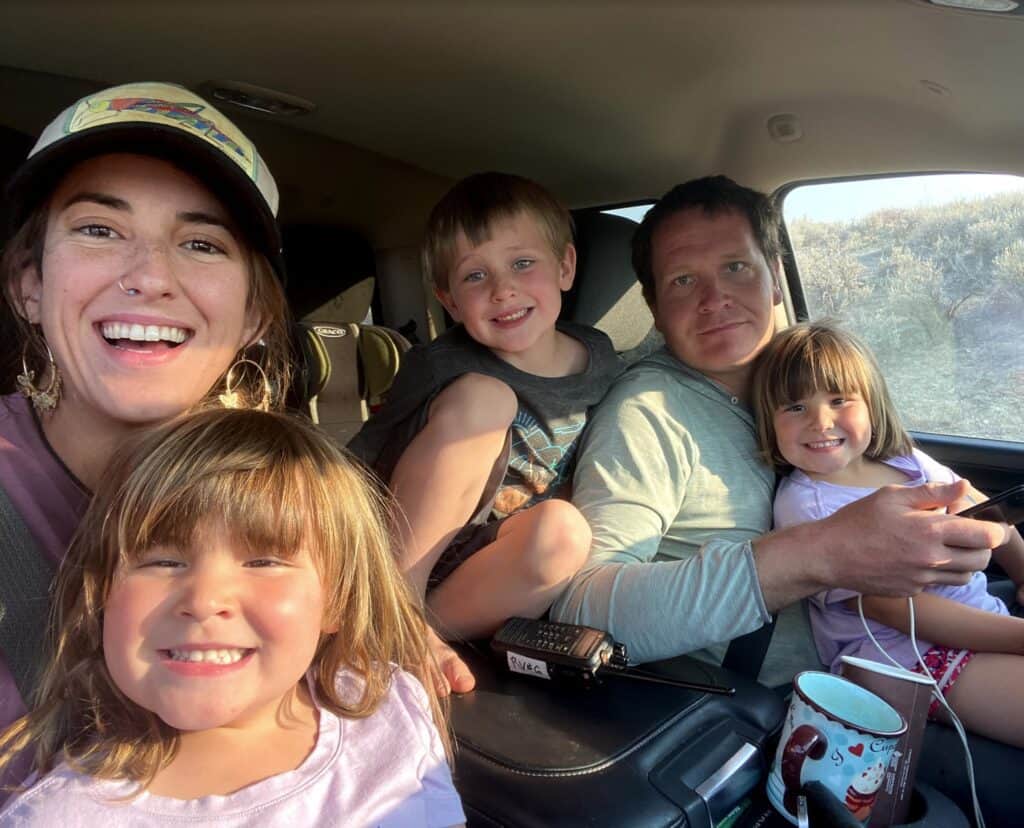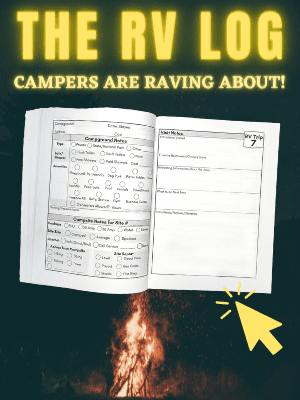Time to talk about everyone’s favorite part of RV life… poop tanks!!
Whether you like it or not, if you’re an RVer, you’re going to have to deal with your own waste face to face. But there are some things you can do to make the process a little more streamlined. Let’s chat about those now.
I’ll answer all your questions about RV black water tanks, plus fill you in on my top tips for dealing with these darn stinking tanks.
Alright, let’s go!
Table of Contents
What Is an RV Black Water Tank?
First of all, let’s define this very important term.
To put it plainly, “black water” is just a fancy term for poop water.
In RVs the black water tank is located under the carriage next to the gray water tank and holds all the waste from your rv toilet! So, it’ll have all your waste, plus toilet paper, plus some chemicals to help degrade the waste and keep the stench down.
How Often Should I Empty My Camper’s Black Water Tank?
This really varies based on how often you use the RV toilet, and how many people are living in the RV. It’s usually going to be around 2-3 times per week, but could be just once per week.
Rather than relying on those numbers though, I’d say stick to the rule of dumping when the tank is around 2/3rds of the way full. That way, there’s enough waste in there to make it easier to dump, but not so much waste that you risk any spillage. Plus, you aren’t driving around with a tank full of poo 🤣.
Once you’ve lived in your RV for a while, you’ll start to get a feel for how often you need to dump the black water tank based on your usage.
Where Can I Dump My Tanks?
You can dump your black water tank at campgrounds, some gas stations and travel centers, and some rest areas.
Some campgrounds have RV sites with sewage hookups right at the site (you might have to pay extra for the sewage hookup), and others have a few dumping stations located around the campgrounds, usually around the entrance or near the garbage bins.
Big truck stops like Love’s and Flying J also have sewage dumping stations. The fee to dump your sewage at these travel centers is usually around $10.
Some rest areas have dump stations too, and some are even free, but they’re harder to come by.
Check out this website which includes a list of RV dump areas by state in the U.S., as well as a super helpful map that shows every RV dump station along with how much it costs to dump there.
How Do I Dump the Black Water Tank? (So I don’t get poo on my hands!)
Okay now for the scary part!!
Just kidding…dumping the black water tank is really not as stinky or messy as you might think. Unless you do something really wrong, you won’t get poo on your hands. But make sure you wear gloves, just in case!
All you have to do is attach your hose (with a clear elbow attachment) to the pipe from your tank, and attach the end of the hose to the dump station. (Make sure that the dump station is below the hookup valve because poop flows downward.)
Then, open the black tank valve and let the waste run. When you can’t see anymore through the clear elbow valve, that means your tank is empty. All you have to do now is close the valve, rinse out the hose, and store it safely away.
Not as scary as you thought, right!?
Need a little more help dumping your waste and storing your sewer hose? Check out these two articles.
- RV Sewer Hose Storage Guide | The Best Ways to Keep Your Hoses Clean & Contained
- Best RV Sewer Hoses 2021, So You Don’t Get Your Hands Dirty
Should I Use Portable RV Waste Tanks (Honey Wagons)?
Portable RV waste tanks, AKA honey wagons, are not a necessity by any means, and you can always get away without one. However, there are some circumstances where they can make RV life a little easier.
The main benefit of using a honey wagon is that you don’t have to drive your whole rig over to a dump station to dump your waste. You just take the honey wagon instead.
One circumstance where a honey wagon might be helpful is if you’re staying long-term at a campsite where you don’t have a sewage hookup at your site. So, instead of driving your rig over to the dumping station every time you have to empty, you just bring your honey wagon.
They also might be helpful if you’re boondocking long-term in a place without hookups. Boondocking often means tricky spots to get in and out of with an RV, so you can instead drive your car and honey wagon to the nearest dumping station instead of having to move and re-park your RV.
The downside to honey wagons though is that they take up a lot of room, so if you’re cramped on space, I’d say stick to using your RV black tank.
If you find that a honey wagon makes sense for your situation, here are a couple of tried and true options:
Camco Rhino Heavy Duty Portable Waste Tank
Source: amazon.com
This Camco Rhino portable waste tank is durable, easy to transport, has no-flat tires, and comes with a high-quality accessory kit so you have everything you need to use it. It also comes with a rinser and backflow prevention valve.
You can choose from tons of different options on Amazon depending on if you want 2 or 4 wheels, and what capacity you’d like (it ranges from 15 to 36 gallons).
Check the current price here.
Barker 4-Wheel Tote Tank
Source: amazon.com
The Barker portable tank is really the old faithful for honey wagon users. It’s durable, can dump while horizontal, has all-terrain wheels, comes fully assembled, and has a built-in full tank indicator.
The only downside to this one is it doesn’t come with an integrated cleaning system like the Camco one does. But it’s cheaper and the maximum capacity option is larger than Camco’s at 42 gallons.
Check the current price on this one here.
Really, either of these options will work great if you need a portable waste tank, so just pick the one that you like better!
One more thing though, if you’re reading this and thinking you may not be up to the challenge or cost of dealing with a black tank (or honey wagon), check out my article on composting toilets. They’re all the rage these days!
Portable camping porta potties are also an option if all this black tank and sewer hose stuff sounds like a little too much work to you.
How To Clean Your RV Black Water Tank
Okay now for the fun part!
Just kidding… but really, once you’ve dumped and cleaned your tank a couple of times, the process becomes really quick and feels like no big deal at all.
There are lots of different products and methods for cleaning your black water tank, and everyone has their own particular way of doing it. These are the four basic steps that you’ll want to do after each time you dump your wastewater.
1) Protect Yourself From Messes
Before you do anything, throw on a pair of gloves. I like to wear rubber gloves that reach up almost to my elbows to stay extra protected (like these), but any pair will do.
2) Drain the Tank
Before you clean it, you gotta drain it. Attach your hose to your camper’s black water tank, open the black water tank valve and let it drain completely through the hose.
Like I mentioned before, drain your black tank first, and then your gray tank (that way the cleaner water from the gray water tank can give a preliminary rinse).
3) Flush the Tank
You absolutely have to flush your rig’s blackwater tank after everytime you drain it. This ensures there’s no hard stuff stuck to the sides which can leave you with a really stinky mess.
There are tons of ways to flush your tank. One popular method is to purchase a flush valve. It lets you attach a freshwater tank hose to the valve that connects to the sewer hose. Then you run water through the hose and tank to rinse it.
You can also use a macerator system, which is similar to the flush valve but instead it uses pressurized water from your fresh water tank to really make sure that tank is clean. This option is a bit more complicated and pricey, though.
4) Add Water
You always need to add water after you’ve drained and flushed your RV black tank. This is crucial in preventing solid waste from getting dry and building up on the sides of the tank. You can do this by just filing your toilet with fresh water and flushing a few times until your tank has some water in it.
5) Add Treatment of Your Choice
And finally, add whatever treatment of your choosing to your tank to help degrade the waste, prevent clogs, and keep everything smelling fresh.
There are tons of different treatment options out there. I highly recommend going with one that is biodegradable and environmentally friendly, like this drop-in treatment, or this liquid treatment.
A lot of articles will tout some DIY treatment solutions. Personally, I’d say to never ever try a DIY treatment for your camper’s black tank as it can seriously mess with the plumbing and possibly create a stinky mess.
Whichever you choose, stick to products that are made to be used in an RV.
Tips for Using Your Black Water Tanks to Avoid Smelly Messes
Always Drain the Black Water Tank First
I know I’ve said this before, but it really is important, and easy to forget if you haven’t been doing this for a long time. Whenever you’re dumping your holding tanks, dump your RV’s black tank first.
Dumping the black water tank first ensures that your hose can be rinsed out by water from the gray water tank. Of course, you’ll still have to clean the hose but the gray water will serve as a preliminary rinse.
Use Septic Safe Toilet Paper
This one’s crucial. You can’t use any regular toilet paper you find at the grocery store. You absolutely need to purchase dissolvable, septic-safe toilet paper that will degrade in your black tank.
Toilet paper that’s not septic safe will give you a messy clog that you really will not have fun dealing with.
Don’t Flush Anything Except Human Waste and Toilet Paper
This tip is also really important for preventing clogs. The only thing that should be flushed down your RV toilet is pee, poop, and septic-safe toilet paper.
No tampons, pads, wipes, or garbage should ever go down the RV toilet or you’ll end up with a nasty clog. Just like you would at home, keep a small waste bin next to the toilet for all the stuff that can’t be flushed.
Keep Enough Water in Your Tank
Your holding tanks should always be at least ⅓ of the way full with water. So, after you dump and clean, fill the tanks with water until they’re at least ⅓ of the way full.
This is especially important for the RV black tank. As you drive your rig around, the water will slosh up the sides of the tank, keeping it clean and helping everything degrade nicely so you don’t get any clogs. When in doubt, more water is better than less!
Always Keep the Black Tank Valve Closed
This one might seem obvious, but you can get some really stinky stuff going on in your RV if you leave your black tank valve open.
Unless waste is actively coming out of the tank, keep the valve closed! Stinky smells from the dumping station can make their way up the hose and into your RV. Gross!!
For more tips on keeping your hands and RV clean, check out my article on the best ways to keep your hoses clean, and tips to organize your RV bathroom.
Camper Black Water Tank FAQs
Should I leave water in my RV black water tank?
Yes!!
Having enough liquid in the tank is crucial to keeping it stink-free. If you don’t have enough water in your black tank, the solids can pile up on the sides of the tank and can make it very hard to empty. This can also create a nasty stench.
So, after you empty, add enough water so the tank is ⅓ of the way full.
What’s the difference between a gray water tank and a black water tank?
A gray water tank holds all the water from your shower and sink drains — the water you used to brush your teeth, wash dishes, or shower.
A black water tank is a separate tank that holds everything you flush down your RV toilet (to put it bluntly, just pee, poo, and toilet paper), and nothing else.
How long can black water stay in an RV tank?
Some people say black water can stay in your RV tank for up to 10 days. I’d say try not to go longer than a week.
If you leave black water in your tank too long, the solid waste could start to dry up and get stinky. If your tank isn’t 2/3rds of the way full but you need to empty, add water until the tank is 2/3rds of the way full and then empty. I’d always stick to emptying as much as you can if you really want to prevent any nasty stinky smells.
Can you drive your RV with a full black water tank?
Yup!
The tanks are designed to be full in a moving vehicle, so it’s really not an issue. Plus, the water sloshing around inside can actually help the waste degrade. I’d say dump when your tank is 2/3rds full just in case, but if you have to drive around with a full tank, there’s really no issue there.
Will my blackwater tank stink?
It shouldn’t!
If your black tank stinks, there’s probably an issue. This could be from not having enough water in the tank, or flushing things that aren’t supposed to go into the black tank. If you can smell your black tank while in your RV, try doing a deep clean, making sure to get in every nook and cranny.
RV Black Water Tanks? Not So Scary After All
That wasn’t so bad, right?? As long as you keep up with maintenance and empty your tank regularly, dealing with your waste in your RV isn’t that bad.
Thanks for reading! While you’re here, check out some of my other RV articles:
- The Ultimate RV Camping Checklists [9 Free Printable RV Checklist PDFs]
- 13+ RV Luxury Items You Don’t Need… BUT WILL LOVE!
- 9 Basic Tools Every RV’er Needs to Carry in their RV Toolbag!!
- 61+ Best RV Organization Accessories and Products of 2021 2021
- Solar Eclipse 2024 Kids Printable Activity Pack! - April 8, 2024
- 11 RV Bathroom Makeovers to Inspire You! - April 7, 2024
- 13 Dreamy Hammock Camping Set Up Ideas + Pics - February 22, 2024




